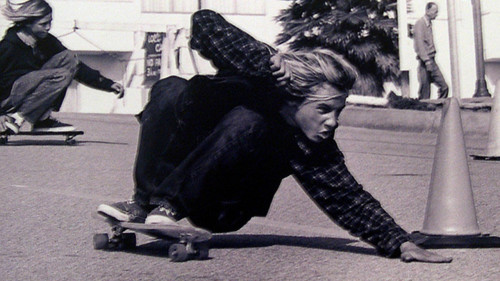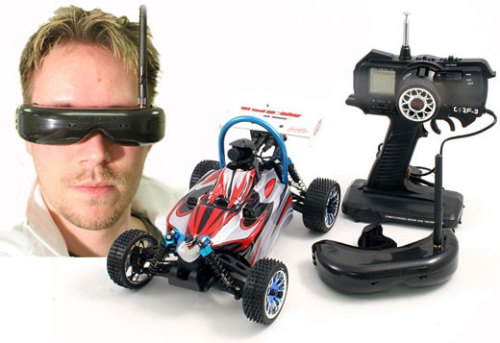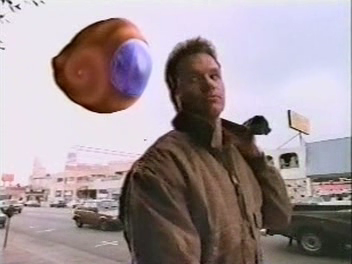
A great quote by Craig Stecyk, 1975:
“two hundred years of american technology has unwittingly created a massive cement playground of unlimited potential. but it was the minds of 11 year olds that could see that potential.”

Not exactly your über cool high-flying drone, but I find remote-controlled cars like this fascinating. The real-time perspective, via the goggles, might be weird.

“Biotic video-game” or more thoroughly described in Design, engineering and utility of biotic games by Ingmar H. Riedel-Kruse , Alice M. Chung , Burak Dura , Andrea L. Hamilton and Byung C. Lee (2011):
Games are a significant and defining part of human culture, and their utility beyond pure entertainment has been demonstrated with so-called ‘serious games’. Biotechnology – despite its recent advancements – has had no impact on gaming yet. Here we propose the concept of ‘biotic games’, i.e., games that operate on biological processes. Utilizing a variety of biological processes we designed and tested a collection of games: ‘Enlightenment’, ‘Ciliaball’, ‘PAC-mecium’, ‘Microbash’, ‘Biotic Pinball’, ‘POND PONG’, ‘PolymerRace’, and ‘The Prisoner’s Smellemma’. We found that biotic games exhibit unique features compared to existing game modalities, such as utilizing biological noise, providing a real-life experience rather than virtual reality, and integrating the chemical senses into play. Analogous to video games, biotic games could have significant conceptual and cost-reducing effects on biotechnology and eventually healthcare; enable volunteers to participate in crowd-sourcing to support medical research; and educate society at large to support personal medical decisions and the public discourse on bio-related issues.

Working on the “Curious Ritual” book project, I found that interview of Bruce Sterling very much in line with what we are exploring (with field observations as the one represented above):
Tish Shute: This year we have seen gestural interfaces go mainstream. What are the most interesting directions for gestural interfaces that you have seen emerge in recent months?
Bruce Sterling: To me, the most “interesting” part is seeing people do gestural stuff in public. William Gibson, my fellow author, observes that cellphones have stolen the gestural language of cigarettes. There’s lots of fidgeting, box tapping, ash-swiping, slipping boxes in and out of pockets… People quickly learn to do that without thinking twice, and they forget how weird it looks. It’s “design dissolving in behavior,” as Adam Greenfield puts it.
This is the Nissan LEAF Start-Up Sounds, which is an electric car and, as such produce almost no noise when starting.
Why do I blog this? Preparing our design fiction video in the Curious Rituals project, Walt showed us this sound as an interesting example of the near future has been represented, and what purpose it can service in the actual design
A curious project by Antonin Fourneau
The “Water Light Graffiti” is a surface made of thousands of LED illuminated by the contact of water. You can use a paintbrush, a water atomizer, your fingers or anything damp to sketch a brightness message or just to draw. Water Light Graffiti is a wall for ephemeral messages in the urban space without deterioration. A wall to communicate and share magically in the city.
Why do I blog this? Because water is an interesting material for interaction design.


“Hard time on planet Earth” is an American science fiction series that aired on CBS in 1989 and caught my attention at the time because of the weird floating robot that constantly moved around the main character. According to the Wikipedia:
After a huge interplanetary war ended, Elite Military Officer is prosecuted for rebellion against the planet’s ruling Council; he was found guilty, but in recognition of his valuable services in the war, he was given the chance to reform by spending an undetermined amount of time in a vastly underpowered human form on planet Earth. Along with him was dispatched “Control” (voiced by Danny Mann), a small floating robot in the form of a mechanical eye with the mission of overseeing Jesse (the earthly name adopted by the alien warrior, from the name tag on the first Earth clothes he wore) to make sure Jesse kept his violent behavior in check. “Control” also provided comic relief to the series, usually by assessing the events with the catchphrase “Negative Outcome. Not Good.”
Why do I blog this? The TV show wasn’t that good but the drone-like robot was a fascinating character. At the time, I remember it as both fascinating and scary… and I guess it can potentially be seen as a weak signal/indicator of potential “personal drones”. Those can exist as a the next iteration of house-arrest monitoring devices, or some sort of personal assistant.

Despite its flawed title, reading My Life as a Telecommuting Robot was intriguing enough. Some excerpts:
During my robot days, I interacted with co-workers I’d never met before, as well as others I hadn’t talked with in years; each of them was compelled to greet me as I cruised down the hall. I chitchatted at the office coffee bar, a more lively scene than sipping coffee alone in my kitchen. But I also nearly careened into glass walls, got stuck in an elevator, could barely hear the discussions in story meetings and got little other writing or interview work done while botting into the newsroom. Technical glitches delayed our progress
Why do I blog this? It’s a very short article and not a deep ethnographic analysis but it highlights interesting aspects of a phenomenon that will be explored in different companies. Although I’m not convinced by this kind of mediated interaction, I’m pretty sure QB-82-like surrogate systems will be employed and will lead to odd situations (beyond drones).
Dephone, by Maria Beltran (Master Media Design, HEAD-Genève):
Smartphones have spread into our daily lives. Their multifunctionality monopolizes the attention and contributes to the addiction of users. Everyday behaviors have changed considerably and now people sharing the same space interact less (physically) with each other. This project is a critical reflection on this reality and an exploration of new types of interaction.

Meanwhile in Switzerland: sheep to warn shepherds of wolf attacks by SMS:
During the experiment, the change in the flock’s heartbeat was found to be significant enough to imagine a system whereby the sheep could be fitted with a collar that releases a repellent to drive the wolf away, while also sending an SMS to the shepherd. The device is aimed at owners of small flocks who lack the funds to keep a sheepdog
Why do I blog this? This is an intriguing example of tech/animal interaction that seem to be more and more common these days. What would the unintended consequences (on the part of the sheep, the wolf and the sheperd)?